Fallen Flags: The Classic American Railroad
Last revised: October 26, 2024
By: Adam Burns
The term "Fallen Flags" describes those railroads whose corporate names have been dissolved through merger, bankruptcy, or liquidation. At one time the United States boasted nearly 140 Class I's.
- According to the Association of American Railroads, prior to 1956 this defined a carrier which earned at least $1 million in annual operating revenue. It has since been revised several times throughout the years. -
Today, many of these classic railroads are but a memory. The older folks reading this can remember those bygone days when corporations like the legendary Atchison, Topeka & Santa Fe Railway, the mighty Pennsylvania Railroad, and prosperous Southern Railway all served America.
And, of course, who can forget our country’s first common carrier, the Baltimore & Ohio Railroad, which survived for 160 years before disappearing into CSX Transportation in 1987.
There are many areas of the industry to study, ranging from locomotives to streamliners. However, few remain as popular, or as enjoyable, as the venerable "fallen flag." They defined the regions they served while providing invaluable transportation needs for local communities.
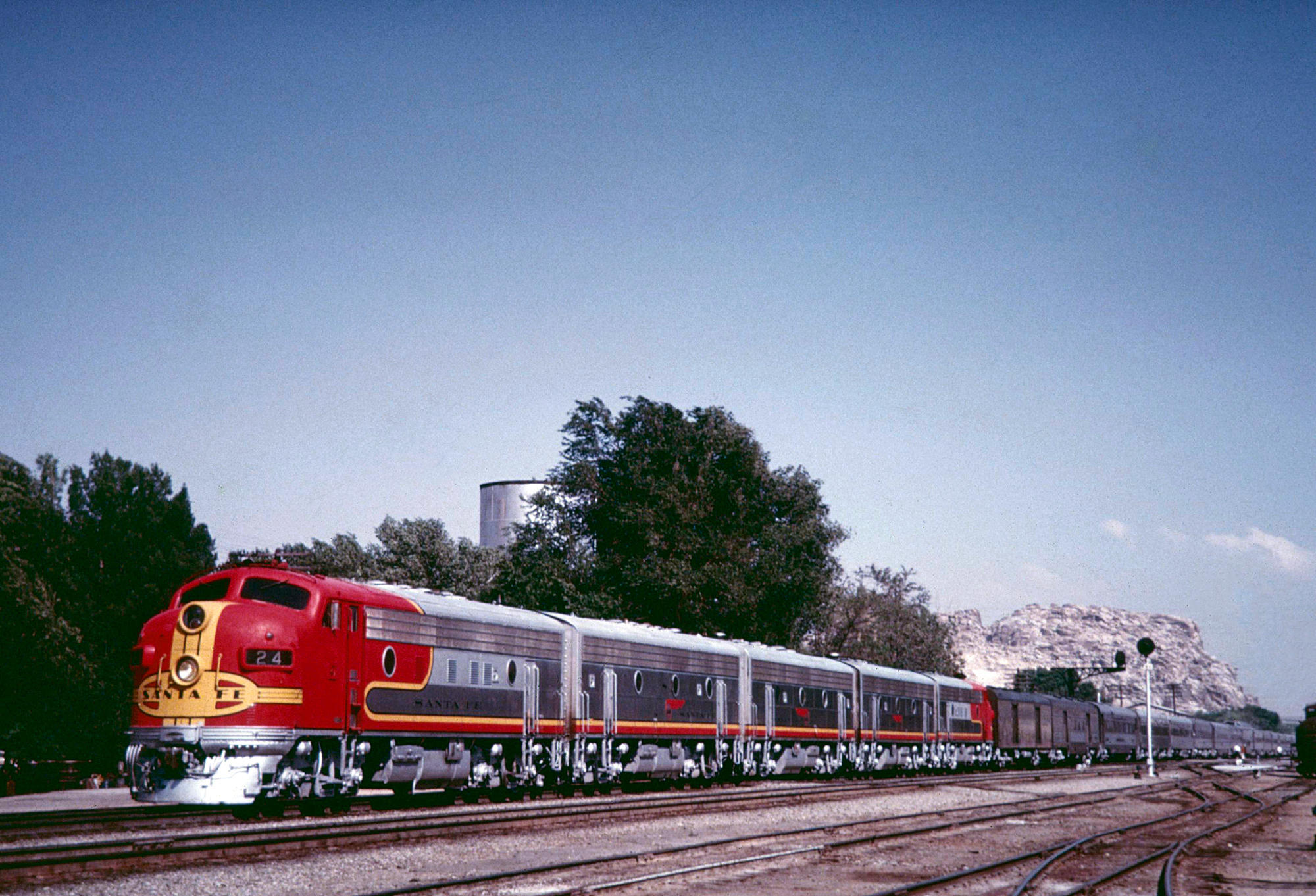 A handsome set of Santa Fe 'F' units, led by F3A #24-L, have train #20, the eastbound "Chief," at Victorville, California. Fred Worsfold photo. American-Rails.com collection.
A handsome set of Santa Fe 'F' units, led by F3A #24-L, have train #20, the eastbound "Chief," at Victorville, California. Fred Worsfold photo. American-Rails.com collection.History
Most of the fallen flags remembered today were derived from systems originally built during the 19th century. Some railroads, such as our country's first common-carrier, maintained their original name for well over a century while others were brought about through either consolidation or reorganization.
The railroad may have been born in England but it quickly caught on in the United States. Following the early chartering of the B&O, Mohawk & Hudson, South Carolina Canal & Railroad Company, and others by 1835 the fledgling country had 1,000 miles of track in operation according to the book "Railroads In The Days Of Steam," published by the editors of American Heritage.
In addition, as John Stover's title, "The Routledge Historical Atlas Of The American Railroads," points out expansion was rapid; of the twenty-six states in the Union by 1840 only four did not contain a single mile of track (Arkansas, Missouri, Tennessee, and Vermont).
Through 1860 there had already been more than $1 billion invested in the industry (interestingly, $200 million of this total came via English or European interests), which then boasted 31,246 miles in service.
At A Glance
1939 - 132 1963 - 102 1978 - 41 1988 - 12 1997 - 9 Present Day - 6 |
|
Until 1956 - $1 million 1956 - $3 million 1965 - $5 million 1978 - $50 million 1997 - $256 million 2019 - $505 million Present Day (2021) - $900 million |
|
98% Intercity Passenger Business 77% Intercity Freight Traffic |
|
Source: Stover, John. Routledge Historical Atlas of the American Railroads, The. New York: Routledge, 1999.
The growth only continued after the Civil War as promoters pushed ribbons of rail westward, highlighted by the completion of the Transcontinental Railroad in May of 1869. Construction quickened after this momentous event and peaked in the 1880's.
During that decade, as historian H. Roger Grant notes in his book, "The Corn Belt Route: A History Of The Chicago Great Western Railroad Company," the national network grew from 93,267 to 163,597 miles! It was the single greatest period of expansion.
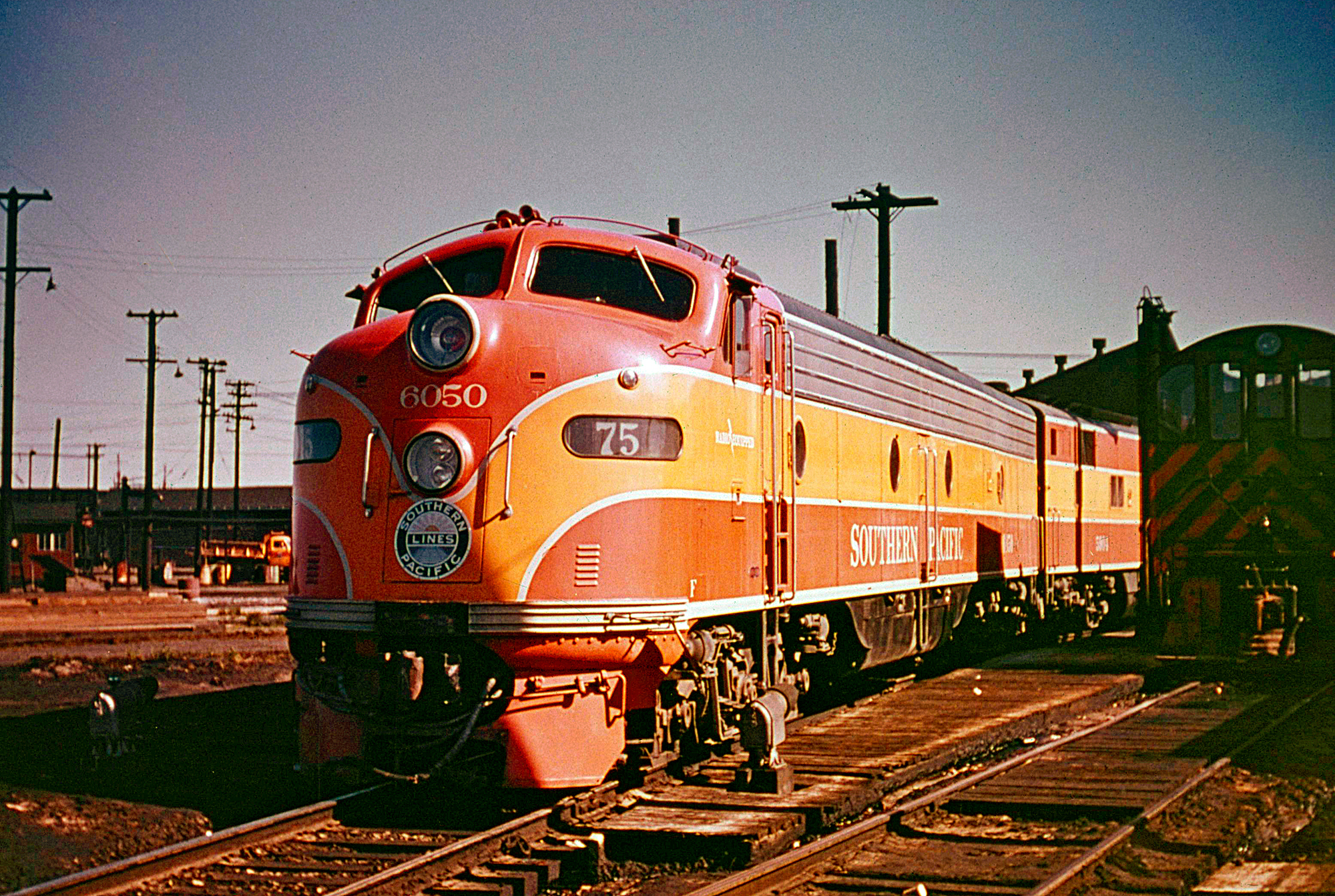 Southern Pacific E9A #6050 has arrived at the Mission Bay Roundhouse and servicing facilities in San Francisco after making a run up the coast with train #75 (Los Angeles - San Francisco) in February, 1955. American-Rails.com collection.
Southern Pacific E9A #6050 has arrived at the Mission Bay Roundhouse and servicing facilities in San Francisco after making a run up the coast with train #75 (Los Angeles - San Francisco) in February, 1955. American-Rails.com collection.Classic American Railroads
The latter 19th century witnessed many fallen flags brought together while others, such as the Western Maryland and Virginian Railway, completed their systems in the early 1900's.
The classic American railroad as we best remember it survived until the 1970's, a decade that reached a crescendo of bankruptcies and mergers.
The government's severe regulations, dating back to the early 20th century, were largely to blame along with the railroads' difficulty in reducing crew sizes (even after technological advancements, including diesel locomotives, wireless radio, and computerization made such possible).
These issues were partially self-inflicted, a result of executive greed and hubris during the 19th century that led to much of the federal oversight.
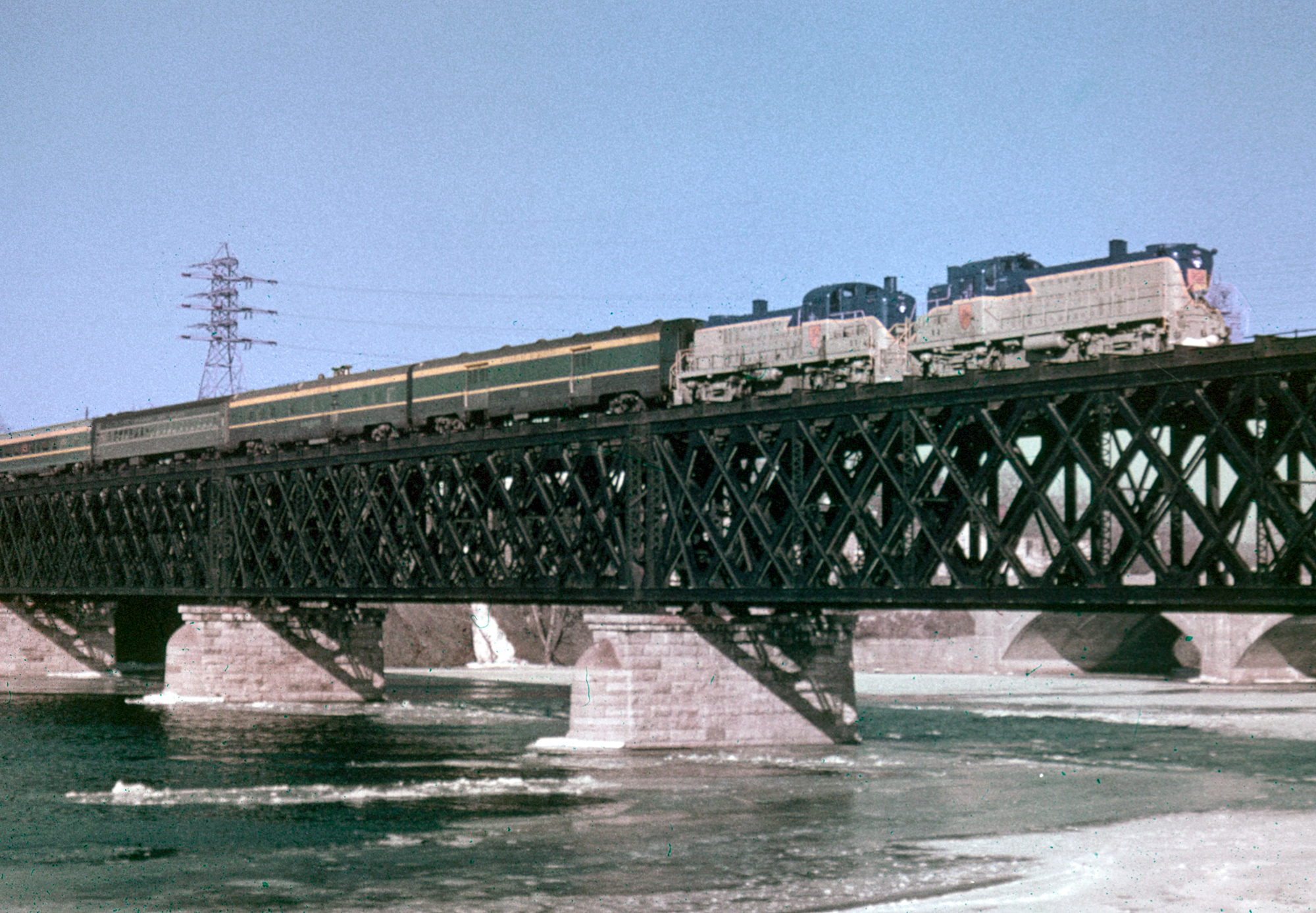 Delaware & Hudson's southbound "Laurentian" crosses the Mohawk River at Cohoes, New York during February of 1968. Jim Shaughnessy photo. Author's collection.
Delaware & Hudson's southbound "Laurentian" crosses the Mohawk River at Cohoes, New York during February of 1968. Jim Shaughnessy photo. Author's collection.While the "Golden Age" officially extended from the 1880's until the Great Depression, ask most railfans the single greatest period and many would point to immediate post-World War II era, through the 1960's.
During this time, although in decline, the industry was still generally profitable while it made the switch from steam to diesel-electric technology.
In addition, numerous, vibrant paint schemes adorned first-generation diesels, built by the five major manufacturers (Electro-Motive, American Locomotive, Fairbanks-Morse, Baldwin, and General Electric).
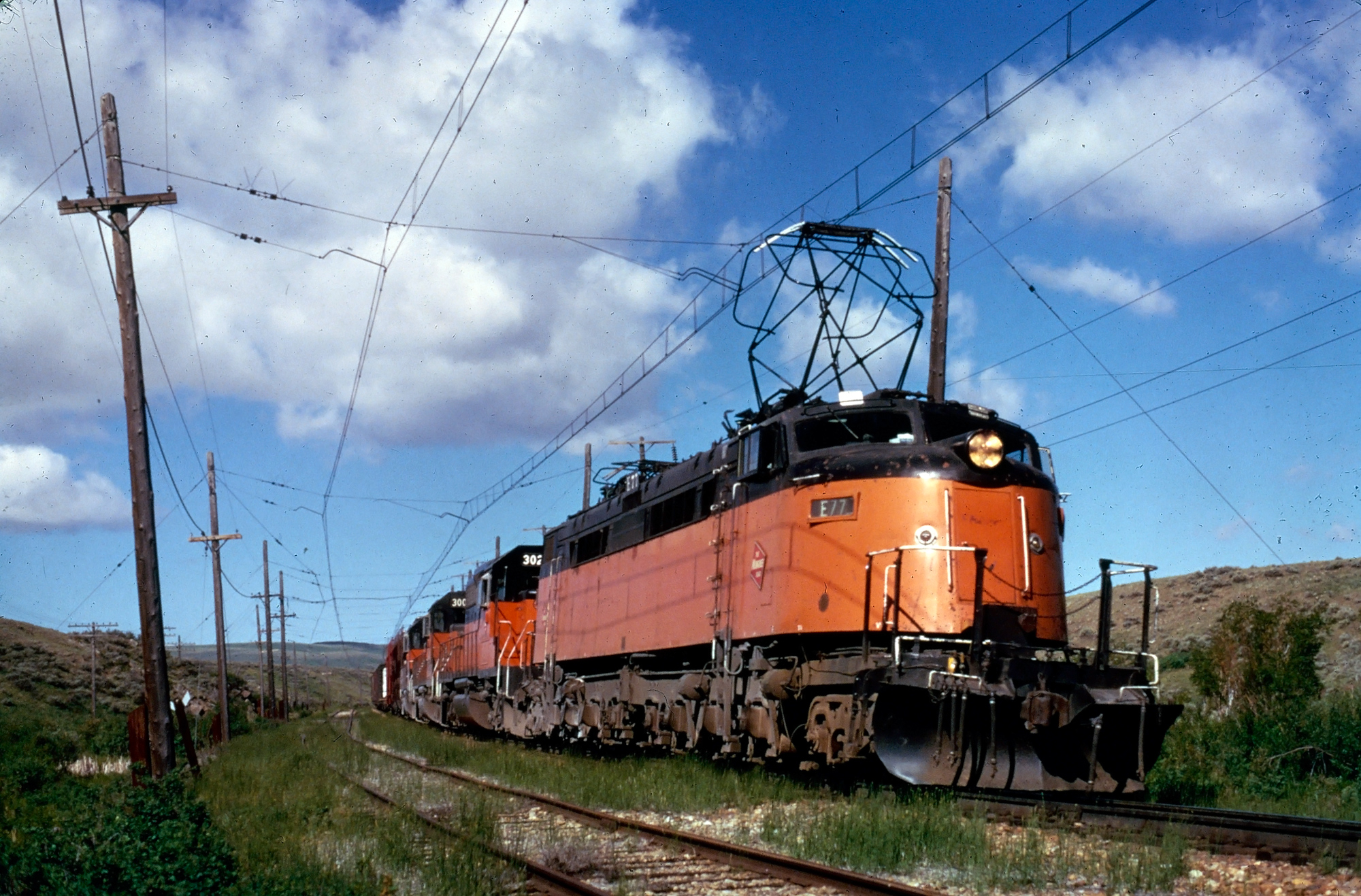 Milwaukee Road "Little Joe" E-77 and a trio of SD40-2's lead an eastbound freight at rural Bruno, Montana on July 1, 1973. American-Rails.com collection.
Milwaukee Road "Little Joe" E-77 and a trio of SD40-2's lead an eastbound freight at rural Bruno, Montana on July 1, 1973. American-Rails.com collection.With a plethora of different emblems roaming the rails it was quite an era for anyone interested in trains. Because these many systems served a particular region it was not uncommon for local communities to call a railroad their own.
Examples here include the New York Central, Reading, New Haven, Western Pacific, Atlantic Coast Line, Missouri Pacific, and the list goes on of carriers serving either a block of states or specific area.
Following the mega-merger movement this is no longer the case as a single railroad can now extend from New York to Chicago or link San Francisco with St. Louis.
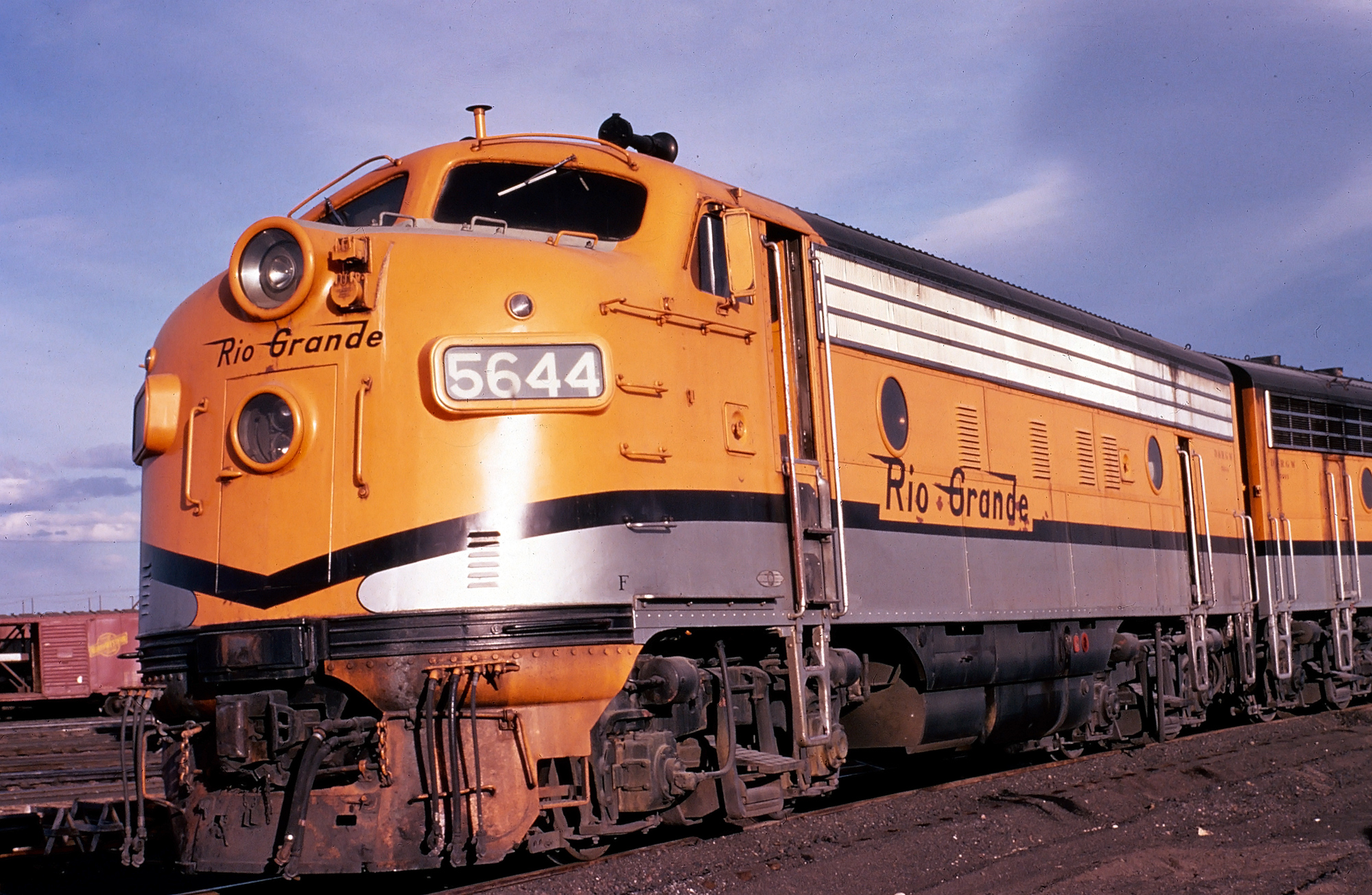 Rio Grande F7A #5644 in Denver, circa 1970. Robert Eastwood, Jr. photo. American-Rails.com collection.
Rio Grande F7A #5644 in Denver, circa 1970. Robert Eastwood, Jr. photo. American-Rails.com collection.Through the many mergers over the years not every classic system has disappeared. The two most notable include Union Pacific and Kansas City Southern; the former has been an American institution for generations.
UP recognized the need to expand and grow as the merger movement picked up adding the Western Pacific, Missouri Pacific, Chicago & North Western, Rio Grande, Missouri-Kansas-Texas, and Southern Pacific to its network from the 1980's through mid-1990's.
In addition, the much smaller Kansas City Southern managed to survive as the smallest Class I system for decades. For many years this regional pike operated a system of less than 1,000 miles connecting Kansas City with the Gulf Coast.
It then rapidly grew during the 1990's as it expanded north into St. Louis and Illinois and south into Mexico. The KCS finally disappeared in April, 2023 when it joined Canadian Pacific to form the Canadian Pacific Kansas City Railroad.
There are many other lesser known railroads which still carry on; names like the Ann Arbor, Florida East Coast, Susquehanna, Escanaba & Lake Superior, Iowa Traction, Louisiana & North Western, and others.
List
Northeast
Baltimore & Ohio Chicago Terminal
"Big Four Route" (Cleveland, Cincinnati, Chicago & St. Louis)
Buffalo, Rochester & Pittsburgh
Central Railroad Of New Jersey
Consolidated Rail Corporation (Conrail)
Delaware, Lackawanna & Western
Maryland & Pennsylvania Railroad ("Ma & Pa")
New York, New Haven & Hartford
Pennsylvania-Reading Seashore Lines
* This railroad is still operating, it is placed here because of its long and storied history.
** The REA was not an operating railroad but was an integral part of the industry during the "golden age" when these now-fallen flags were still operating.
Southeast
Atlantic & East Carolina Railway
Cincinnati, New Orleans and Texas Pacific Railway
Nashville, Chattanooga & St. Louis
Norfolk Southern Railway (Original)
Shamrock Coal Company's Oneida & Western
Richmond, Fredericksburg & Potomac
Tennessee, Alabama & Georgia Railway
West Point Route: Georgia Railroad/A&WP/WRoA
* This railroad is still operating, it is placed here because of its long and storied history.
Midwest
Chicago, Rock Island & Pacific
Chicago, South Shore & South Bend
Davenport, Rock Island & Northwestern
Duluth, South Shore & Atlantic
International – Great Northern Railroad
Minneapolis, Northfield & Southern
Minneapolis, St. Paul & Sault Ste. Marie (Soo Line)
Missouri-Kansas-Texas Railroad (Katy)
Monon Railroad (Chicago, Indianapolis & Louisville)
New York, Chicago & St. Louis (Nickel Plate Road)
Pittsburgh, Cincinnati, Chicago and St. Louis Railroad (Panhandle Route)
St. Louis Southwestern (Cotton Belt)
St. Louis-San Francisco Railway (Frisco)
Toledo, St. Louis and Western Railroad
* This railroad is still in operation but is placed here due to its historical significance.
** Despite still being in operation the original TP&W is technically one of the many fallen flags presented here since it disappeared into the Santa Fe in 1983. The company was reborn in 1988.
West/Southwest
SPSF Railway (Santa Fe-Southern Pacific)
Northwest
Milwaukee Road's Pacific Extension
Canada
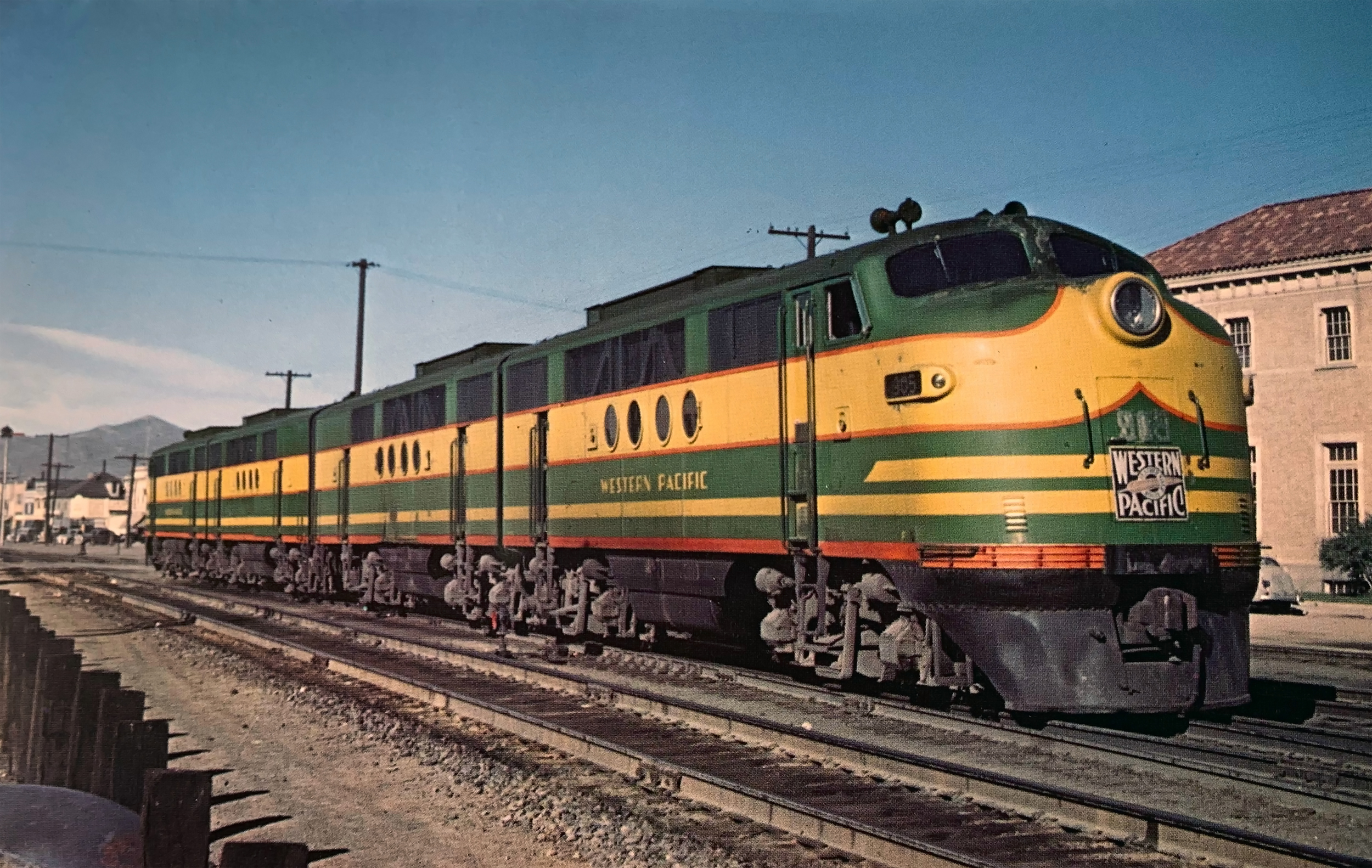 A beautiful set of Western Pacific FT's (#900/A/B/C) await their next assignments on Southern Pacific's "drill track" in downtown Elko, Nevada on June 13, 1946. According to Virgil Staff: "The famous paired trackage agreement, formalized between Western Pacific and Southern Pacific railroads on February 28, 1924 enables operation of all eastbound traffic over the Western Pacific and all westbound over the Southern Pacific. Between Wesco and bridge 633.47 where the Southern Pacific crosses underneath, the Western Pacific eastbound trackage lies to the north of the Southern Pacific. From bridge 633.47 to Alazon the Southern Pacific lies to the north and the Western Pacific to the south." Richard Kindig photo. American-Rails.com collection.
A beautiful set of Western Pacific FT's (#900/A/B/C) await their next assignments on Southern Pacific's "drill track" in downtown Elko, Nevada on June 13, 1946. According to Virgil Staff: "The famous paired trackage agreement, formalized between Western Pacific and Southern Pacific railroads on February 28, 1924 enables operation of all eastbound traffic over the Western Pacific and all westbound over the Southern Pacific. Between Wesco and bridge 633.47 where the Southern Pacific crosses underneath, the Western Pacific eastbound trackage lies to the north of the Southern Pacific. From bridge 633.47 to Alazon the Southern Pacific lies to the north and the Western Pacific to the south." Richard Kindig photo. American-Rails.com collection.Here within this page you will find information on some of the best remembered fallen flags, each described in much more detail, broken down into the territory where they operated.
Since the website debuted I have finally had the chance to feature many of these although I realize that some are still omitted. As time allows, I will try to cover most of these companies. As it currently stands there are already more than 100 such systems highlighted.
You may notice that Canadian National and Canadian Pacific are now included in the website. After giving it much thought the two lines have played too significant a role in our nation's railroad history, especially in its current and future state, to be left out and unmentioned.
For instance several are now of Canadian ownership/control such as the Soo Line (and indirectly the Milwaukee Road through the Soo's takeover by CP), Delaware & Hudson (today, partially owned by Norfolk Southern), Illinois Central, Grand Trunk Western, Central Vermont, and the Duluth, Winnipeg & Pacific Railway.
Contents
Recent Articles
-
Oregon Railroad Museums: A Complete Guide
Apr 25, 25 03:11 PM
With its rich tapestry of scenic landscapes and profound historical significance, Oregon possesses several railroad museums that offer insights into the state’s transportation heritage. -
North Carolina Railroad Museums: A Complete Guide
Apr 25, 25 02:56 PM
Today, several museums in North Caorlina preserve its illustrious past, offering visitors a glimpse into the world of railroads with artifacts, model trains, and historic locomotives. -
New Jersey Railroad Museums: A Complete Guide
Apr 25, 25 11:48 AM
New Jersey offers a fascinating glimpse into its railroad legacy through its well-preserved museums found throughout the state.

